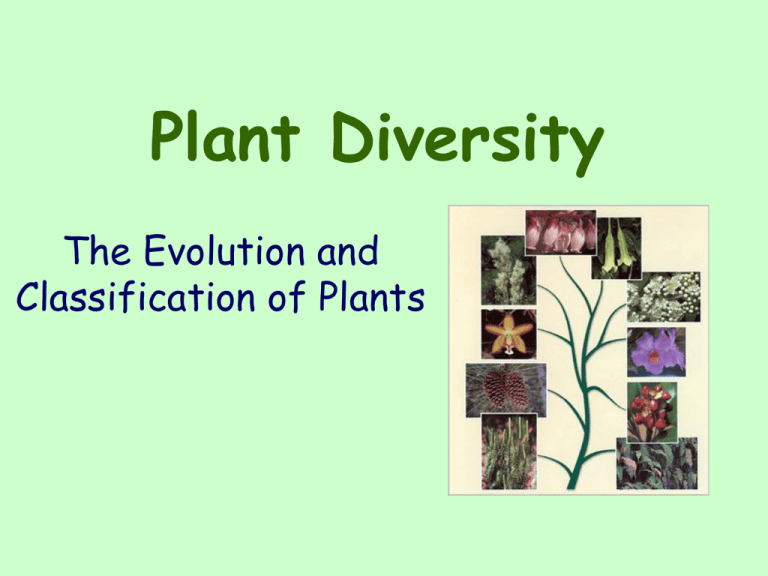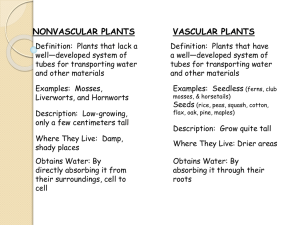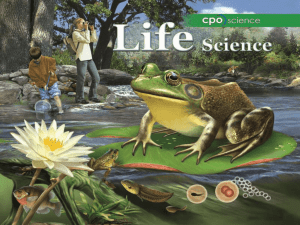Plant Divisions
advertisement

Plant Diversity The Evolution and Classification of Plants Why should we care about plants, at all? Carbon dioxide levels Indicators for ground level pollution, long before animals Japan/ radioactive food…. But… Kudzu- invasive Did you know…… Oak trees do not reach sexual maturity with acorns until they are fifty years old or older And that you are 16 times more likely to be struck by lightning if you’re standing under an oak tree than any other type of tree Did you know…. Bamboo can grow up to three feet in a 24 hour period. Did you know… The squirting cucumber (Ecballium elaterium), when brushed by a passerby, ejects its seeds and a stream of poisonous juice that stings the skin Did you know… Fruits have become more expensive because we have killed more bees (and birds) with insecticides…. What do I know about plants? True or False 1. All plants perform photosynthesis. 2. All plants need water and nutrients. 3. All plants reproduce using flowers. 4. All plants reproduce using seeds. 5. Plants eat soil 6. Some plants lose their leaves in the winter because it gets too cold 7. Plants know their up from their down 8. Plants have hormones the same way we do 9. Leaves are different on the two sides Random thought questions…. • Are there girl and boy plants? • Why are mosses so short, and why do they live only in moist areas? • When you eat an apple, what are you really eating? • If this whole ‘we came from bacteria thing’ is true, where do scientists think plants came from? Precursors to plants…algae? PLANT CHARACTERISTICS: • • • • Multicellular,eukaryotic, autotrophic Can’t move Photosynthesize and have chlorophyll Cell Walls made of cellulose Plants Make the Move to Land The ancestors of plants were multicellular green algae. They were completely immersed in water & dissolved minerals. To move onto land, plants had to solve these problems: 1. How to get chemical resources (water, minerals, oxygen, and carbon dioxide) separated into air and soil 2. How to transport resources within the plant. 3. How to prevent from drying out 4. How to reproduce without water Some Adaptations (solutions)1. Have a protective layer – cuticle (waxy outer layer) to keep from drying out Some Adaptations (solutions)2. Have body parts extending into both air and soil (roots) 3. Have leaves – photosynthesis takes place on tops of leaves Some Adaptations (solutions)4. Develop a vascular system to transport resources in plant 5. . Specialized structures for reproduction including spores & sex cells (seeds) that do not dry out Plant Growth: In response to seasons … Evergreen Deciduous Plant Growth: In response to stimuli … Gravitropism Phototropism They grow towards light, which is usually away from where gravity is trying to pull them … Plants are classified based on whether or not they have 1. Vascular System ( pipes for transport) 2. Seeds 3. Flowers (enclosed seeds) Nonvascular Plants 1. Most primitive plants 2. NO “pipes” (vascular system) 3. Small size due to no vascular tissue 4. No true roots, stems, or leaves 5. Most common example: Mosses, liverworts Nonvascular Plants 6. Need WATER to reproduce 7. Reproduction can be sexual or asexual 8. Tend to be located near water or in moist/shady places. Typical Moss Plant (most common bryophyte) NO TRUE roots, stems Tracheophytes (Ferns) -Vascular Plants- Contains vascular tissues.. But not much else! The Fern - a seedless vascular plant 1. Contain a vascular system – can grow taller than mosses 2. They grow in moist, shady habitats.WHY????? There are 11,000 species of ferns. Vascular-seedless 3. Has underground stems, roots, & large leaves called fronds. 4. Reproduction can be sexual or asexual 5. Example: Ferns, horsetails, club mosses Gymnosperms- “naked seed” • Cycad (Sago palm), • Ginkgo, • Conifer (pine, spruce, firs, cedars, sequoias, redwoods, junipers, yews, & cypress trees) Sago Palm Ginkgo Ginkgo Gymnosperms • • • • Have pipes and seeds, but no flowers Reproduction relies on wind and water Use cones and pollen Example: Pine trees Gymnosperms-Conifers 1. Most common gymnosperms are Conifers 2. Conifers have leaves called needles or scales have a reduced surface area and thick waxy coat on the needle to reduce water loss and prevents freezing. Pine Juniper Sequoia How do gymnosperms spread their seeds? Conifer Reproduction 1. Male cones produce pollen and the female cone produces eggs and seeds. 2. Pollen is inefficiently transferred by the wind. 3. Once mature, the scales on the female cone dry out and open scattering the seeds by the wind. Pollen Cone Pollen Seed Cone Angiosperms- “enclosed seeds” Angiosperms- “enclosed seeds” 1. These are flowering plants the encourage direct and efficient pollen transfer (smell, color and offering nectar) 2. Pollinators are flying insects, birds, and bats that transfer pollen from flower to flower. 3. Flowers contain ovaries, which is where eggs/seeds are produced. 4. A fruit is the pollinated ovary containing mature seeds. • • • • Angiosperms- “enclosed seeds” Has pipes, seeds, and flowers Reproduction with flowers: Male Parts: stamen (anther and filament) Female Parts: Pistil (stigma, style, overy) Fruit can aid in dispersal of seed to reduce competition with parent plant. 1. 2. 3. 4. Winged fruit Floating fruit Fleshy fruit Spiny fruit Maple seeds: Winged fruit Burdock: Spiny fruit Review of Plant Evolution: Quiz Time • What did plants have to overcome to live on land? • What is the most primitive division of plants because they have no vascular system? • What is the most common example in this division and how do they reproduce? • Why are mosses so small? • What is the division of plants that contain a vascular system? • What did a vascular system do for plants sizewise? • How are mosses and ferns different? • How are mosses and ferns alike? Quiz Time • How are Tracheophytes different from bryophytes? • How are tracheophytes divided? • What are the advantages of seeds over spores? • What other advantages did seed-bearing plants have over spore-bearing plants? • What are the two divisions of the seedbearing tracheophytes? Quiz Time • What does the term Gymnosperm mean? • What are the most common of the Gymnosperms? • What is the evolutionary importance of needles? • What structures do conifers use to reproduce? • Were are seeds located in the cone? • Even though wind-dispersal of pollen is inefficient, what did it allow plants to overcome?







